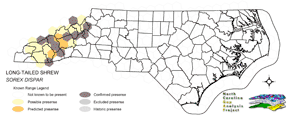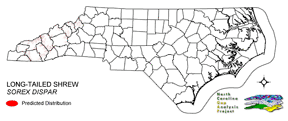
| Taxa: |
| Order: |
| Family: |
| Mammalia |
| Insectivora |
| Soricidae |
| NatureServe Global Rank: |
| NatureServe State (NC) Rank: |
| G4 |
| S2 |
| Federal Status: |
| NC State Status: |
| --- |
| SC |


| Land Unit |
| US Fish & Wildlife Service |
| US Forest Service |
| US National Park Service |
| US Department of Defense |
| NC State Parks |
| NC University System |
| NC Wildlife Res. Com. |
| NC Forest Service |
| NC Div. of Coastal Mgmt. |
| Local Governments |
| Non-Governmental Org. |
| Other Public Lands |
| Private Lands |
| GAP Status 1-2 |
| All Protected Lands |
| Statewide |
| Hectares |
| 0.00 |
| 15,443.46 |
| 0.00 |
| 8,235.63 |
| 3.78 |
| 0.00 |
| 107.55 |
| 0.45 |
| 0.00 |
| 453.69 |
| 545.40 |
| 0.00 |
| 17,522.28 |
| 10,688.67 |
| 24,776.91 |
| 42,312.24 |
| Acres |
| 0.00 |
| 38,161.61 |
| 0.00 |
| 20,350.68 |
| 9.34 |
| 0.00 |
| 265.76 |
| 1.11 |
| 0.00 |
| 1,121.09 |
| 1,347.71 |
| 0.00 |
| 43,298.49 |
| 26,412.27 |
| 61,225.07 |
| 104,555.80 |
| % of Dist. on |
| Prot. Lands |
| 0.0 % |
| 62.3 % |
| 0.0 % |
| 33.2 % |
| < 0.1 % |
| 0.0 % |
| 0.4 % |
| < 0.1 % |
| 0.0 % |
| 2.1 % |
| 2.1 % |
| 0.0 % |
| 0.0 % |
| 43.1 % |
| ----- |
| ----- |
| % of Dist. on |
| All Lands |
| 0.0 % |
| 36.5 % |
| 0.0 % |
| 19.5 % |
| < 0.1 % |
| 0.0 % |
| 0.3 % |
| < 0.1 % |
| 0.0 % |
| 1.1 % |
| 1.3 % |
| 0.0 % |
| 41.4 % |
| 25.3 % |
| ----- |
| ----- |
|
The southern Appalachian mountains are the southern limit of the shrew's breeding range, where it is found in high-elevation deciduous and coniferous forest types in the southern Appalachians (Linzey and Linzey 1971). Occurs in the western North Carolina mountains in two types of habitat; under and among rocks and boulders, especially talus slopes, and along streams (Whitaker and Hamilton 1998). This species characteristically prefers moist ravines, slopes and stream banks with large areas of rock talus or downed and over-piled logs (Lowman 1975). It takes shelter in moss, leaf mould and the roots of trees within and among the labyrinth of cracks and crevices of rock fields, talus and log piles (Forsyth 1985). NATURE SERVE GLOBAL HABITAT COMMENTS: Mountainous, forested areas (deciduous or evergreen) with loose talus. Rocky damp areas with deep crevices covered by leaf mold and roots are preferred. May occur along small mountain streams. Will use artificial talus created by road construction and pit mines. 'SOREX DISPAR is probably the most stenotopic mammal in eastern North America...' (Webster 1987). Trapping results reported by Richmond and Grimm (1950) suggest that long-tailed shrews spend most of their time in the labyrinth of spaces between rocks about a foot beneath the surface. Nest sites are usually associated with natural subterranean tunnels among boulder crevices. |
| Code | Name | Description | NC Natural Heritage Program Equivalent |
| 521 | Spruce/Fir Forest | High Elevation Frazer-Fir - Red Spruce, Red Spruce and Red-Spruce-Yellow Birch Forests. Tree densities included here include both woodland to forest density. Highly intermixed with Northern Hardwoods, Grassy Balds, and Shrub Balds. | Red Spruce--Fraser Fir Forest, Fraser Fir Forest |
| 522 | Northern Hardwoods | High Elevation forests including yellow birch, American beech, and yellow buckeye. Includes forests with Hemlock and Yellow Birch. | Northern Hardwoods Forest, Boulderfield Forest |
| 525 | Appalachian Oak Forest | A variety of oak forest types including Black, White, Scarlet Oaks in dry to mesic situations. Includes forests historically co-dominated by American Chestnut. | High Elevation Red Oak Forest, Montane White Oak Forest |
| 526 | Appalachian Cove Forest | Mixed Mesophytic forests of the mountains. Includes tuliptree, basswood, yellow buckeye and surgar maple. This class is mapped to include cove forests dominated or co-dominated by hemlock. | Rich Cove Forest, Acidic Cove Forest |
| 527 | Appalachian Hemlock | Upland hemlock forests of the moutains region. Vary from side slopes to steep slope positions. | Canada Hemlock Forest |
| 528 | Appalachian Xeric Pine Forest | Pine forests and woodlands on xeric sites. A variety of pines, including Virginia, Shortleaf, Eastern White Pine, Table Mountain and Pitch pine. Often small areas of dense pine within a matrix of Xeric Oak-Pine Forests. | Pine Oak Heath |
| 529 | Appalachian Xeric Mixed Forest | Mixed forests with Virginia, Shortleaf, Eastern White Pine, Table Mountain and Pitch pines in combination with xeric oak species. Oaks include, white, Southern Red, black, and rock chestnut. | Pine Oak Heath |
| 530 | Appalachian Xeric Deciduous Forest | Deciduous forests in the mountains dominated by Xeric Oak species. Species include, white, Southern red, black, and rock chestnut. | High Elevation Red Oak Forest, Montane White Oak Forest |
| 535 | Talus/Outcrops/Cliffs | Includes seep talus slopes with sparce vegetation, as well as outcrops including, granitic outcrops. Some outcrops will have been mapped as barren rock. | No equivalent |
|
Kirkland, G.L. 1981. Sorex dispar and Sorex gaspensis. Am.Soc. Mamm., Mammalian Species No. 155. pp. 1-4.
George, S. B. 1988. Systematics, historical biogeography, and evolution of the genus SOREX. J. Mammalogy 69:443-461. Jackson, H. H. T. 1928. A taxonomic review of the American long-tailed shrews (genera SOREX and MICROSOREX). North American Fauna 51:1-238. Churchfield, S. 1992. The Natural History of Shrews. Cornell University Press, Ithaca, New York. 192 pp. Lowman, G. E. 1975. A survey of endangered, threatened, rare, status-undetermined, peripheral, unique mammals of thes.e. National Forests and Grasslands. USDA Forest Service Contract 38-2601. 121 pp. Kirkland, G.L., Jr. and H.M. Van Deusen. 1979. THE SHREWS OF THE SOREX DISPAR GROUP:SOREX DISPAR BATCHELDER AND SOREX GASPENSIS ANTHONY AND GOODWIN. AMER. MUS. NOVITATES NO. 267521 PP. Whitaker, J.O. Jr. and W.J. Hamilton, Jr. 1998. Mammals of the eastern United States. Cornell Univ. Press, Ithaca, New York. 583 pp. French, T. W., and G. L. Kirkland, Jr. 1983. Taxonomy of the Gaspe shrew, SOREX GASPENSIS, and the rock shrew, S. DISPAR. Can. Field-Nat. 97:75-78. Linzey, Alicia V., & Donald W. Linzey. 1971. Mammals of the Great Smoky Mountains National Park. The University of Ten- nessee Press, Knoxville, Tennessee. 114 p. Doutt, J. Kenneth, Caroline A. Heppenstall, John E. Guilday.1977. MAMMALS OF PENNSYLVANIA. THE PENN. GAME COMMISSION. 283 PP. Godin, A.J. 1977. Wild Mammals of New England. Johns Hopkins University Press, Baltimore. 304 pp. van Zyll de Jong, C. G. 1983. Handbook of Canadian Mammals. 1. Marsupials and insectivores. Nat. Mus. Canada, Ottawa. 212 pp. Forsyth, A. 1985. Mammals of the American north. Camden House, Camden East, Ontario. 351pp. Scott, F. W. 1987. First record of the long-tailed shrew, SOREX DISPAR, from Nova Scotia. Canadian Field-Nat. 101:404-407. Webster, W. D. 1987. SOREX DISPAR BLITCHI Schwartz. Rock shrew. Pages 39-40 in M. K. Clark (ed.). Endangered, threatened and rare fauna of North Carolina, Part I. A re-evaluation of the mammals. Occas. Papers North Carolina Biol. Surv. Handley, C. O., Jr. 1991. Mammals. Pages 539-616 in K. Terwilliger, coordinator. Virginia's endangered species:proceedings of a symposium. McDonald and Woodward Publishing Company, Blacksburg, Virginia. |
For more information please contact them at:
NC-GAP Analysis Project
Dept. of Zoology, NCSU
Campus Box 7617
Raleigh, NC 27695-7617
(919) 513-2853
www.basic.ncsu.edu/ncgap